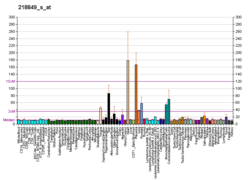PPP1R13L
RelA-associated inhibitor is a protein that in humans is encoded by the PPP1R13L gene.[5][6]
Interactions
PPP1R13L has been shown to interact with Sp1 transcription factor[7] and RELA.[5][7]
References
- 1 2 3 GRCh38: Ensembl release 89: ENSG00000104881 - Ensembl, May 2017
- 1 2 3 GRCm38: Ensembl release 89: ENSMUSG00000040734 - Ensembl, May 2017
- ↑ "Human PubMed Reference:".
- ↑ "Mouse PubMed Reference:".
- 1 2 Yang JP, Hori M, Sanda T, Okamoto T (Jun 1999). "Identification of a novel inhibitor of nuclear factor-kappaB, RelA-associated inhibitor". J Biol Chem. 274 (22): 15662–70. doi:10.1074/jbc.274.22.15662. PMID 10336463.
- ↑ "Entrez Gene: PPP1R13L protein phosphatase 1, regulatory (inhibitor) subunit 13 like".
- 1 2 Takada, Norio; Sanda Takaomi; Okamoto Hiroshi; Yang Jian-Ping; Asamitsu Kaori; Sarol Lilen; Kimura Genjiro; Uranishi Hiroaki; Tetsuka Toshifumi; Okamoto Takashi (Aug 2002). "RelA-Associated Inhibitor Blocks Transcription of Human Immunodeficiency Virus Type 1 by Inhibiting NF-κB and Sp1 Actions". J. Virol. United States. 76 (16): 8019–30. doi:10.1128/JVI.76.16.8019-8030.2002. ISSN 0022-538X. PMC 155123. PMID 12134007.
Further reading
- Liu ZJ, Lu X, Zhong S (2005). "ASPP--Apoptotic specific regulator of p53". Biochim. Biophys. Acta. 1756 (1): 77–80. doi:10.1016/j.bbcan.2005.08.002. PMID 16139958.
- Takada N, Sanda T, Okamoto H, et al. (2002). "RelA-Associated Inhibitor Blocks Transcription of Human Immunodeficiency Virus Type 1 by Inhibiting NF-κB and Sp1 Actions". J. Virol. 76 (16): 8019–30. doi:10.1128/JVI.76.16.8019-8030.2002. PMC 155123. PMID 12134007.
- Strausberg RL, Feingold EA, Grouse LH, et al. (2003). "Generation and initial analysis of more than 15,000 full-length human and mouse cDNA sequences". Proc. Natl. Acad. Sci. U.S.A. 99 (26): 16899–903. Bibcode:2002PNAS...9916899M. doi:10.1073/pnas.242603899. PMC 139241. PMID 12477932.
- Bergamaschi D, Samuels Y, O'Neil NJ, et al. (2003). "iASPP oncoprotein is a key inhibitor of p53 conserved from worm to human". Nat. Genet. 33 (2): 162–7. doi:10.1038/ng1070. PMID 12524540.
- Colland F, Jacq X, Trouplin V, et al. (2004). "Functional Proteomics Mapping of a Human Signaling Pathway". Genome Res. 14 (7): 1324–32. doi:10.1101/gr.2334104. PMC 442148. PMID 15231748.
- Gerhard DS, Wagner L, Feingold EA, et al. (2004). "The Status, Quality, and Expansion of the NIH Full-Length cDNA Project: The Mammalian Gene Collection (MGC)". Genome Res. 14 (10B): 2121–7. doi:10.1101/gr.2596504. PMC 528928. PMID 15489334.
- Slee EA, Gillotin S, Bergamaschi D, et al. (2005). "The N-terminus of a novel isoform of human iASPP is required for its cytoplasmic localization". Oncogene. 23 (56): 9007–16. doi:10.1038/sj.onc.1208088. PMID 15489900.
- Issaeva N, Bozko P, Enge M, et al. (2005). "Small molecule RITA binds to p53, blocks p53-HDM-2 interaction and activates p53 function in tumors". Nat. Med. 10 (12): 1321–8. doi:10.1038/nm1146. PMID 15558054.
- Zhang X, Wang M, Zhou C, et al. (2005). "The expression of iASPP in acute leukemias". Leuk. Res. 29 (2): 179–83. doi:10.1016/j.leukres.2004.07.001. PMID 15607367.
- Laska MJ, Nexø BA, Vistisen K, et al. (2005). "Polymorphisms in RAI and in genes of nucleotide and base excision repair are not associated with risk of testicular cancer". Cancer Lett. 225 (2): 245–51. doi:10.1016/j.canlet.2005.03.021. PMID 15885892.
- Skjelbred CF, Saebø M, Nexø BA, et al. (2006). "Effects of polymorphisms in ERCC1, ASE-1 and RAI on the risk of colorectal carcinomas and adenomas: a case control study". BMC Cancer. 6: 175. doi:10.1186/1471-2407-6-175. PMC 1533843. PMID 16817948.
- Beausoleil SA, Villén J, Gerber SA, et al. (2006). "A probability-based approach for high-throughput protein phosphorylation analysis and site localization". Nat. Biotechnol. 24 (10): 1285–92. doi:10.1038/nbt1240. PMID 16964243.
- Bergamaschi D, Samuels Y, Sullivan A, et al. (2006). "iASPP preferentially binds p53 proline-rich region and modulates apoptotic function of codon 72-polymorphic p53". Nat. Genet. 38 (10): 1133–41. doi:10.1038/ng1879. PMID 16964264.
- Olsen JV, Blagoev B, Gnad F, et al. (2006). "Global, in vivo, and site-specific phosphorylation dynamics in signaling networks". Cell. 127 (3): 635–48. doi:10.1016/j.cell.2006.09.026. PMID 17081983.
- Zhang X, Diao S, Rao Q, et al. (2007). "Identification of a novel isoform of iASPP and its interaction with p53". J. Mol. Biol. 368 (4): 1162–71. doi:10.1016/j.jmb.2007.03.001. PMID 17391696.
- Laska MJ, Strandbygård D, Kjeldgaard A, et al. (2007). "Expression of the RAI gene is conducive to apoptosis: studies of induction and interference". Exp. Cell Res. 313 (12): 2611–21. doi:10.1016/j.yexcr.2007.05.006. PMID 17570360.
This article is issued from
Wikipedia.
The text is licensed under Creative Commons - Attribution - Sharealike.
Additional terms may apply for the media files.




